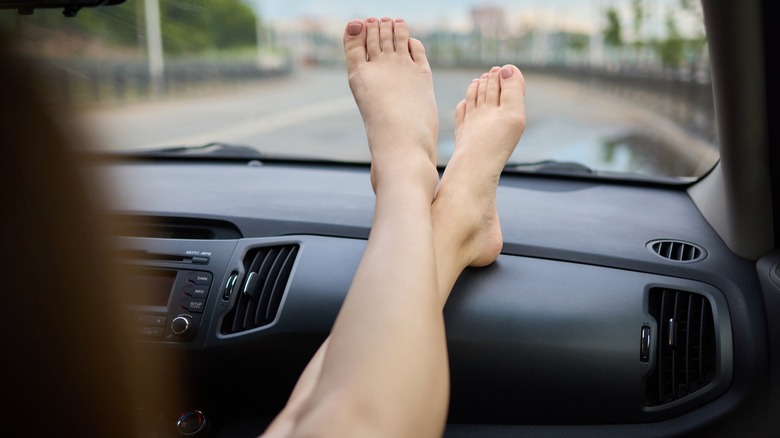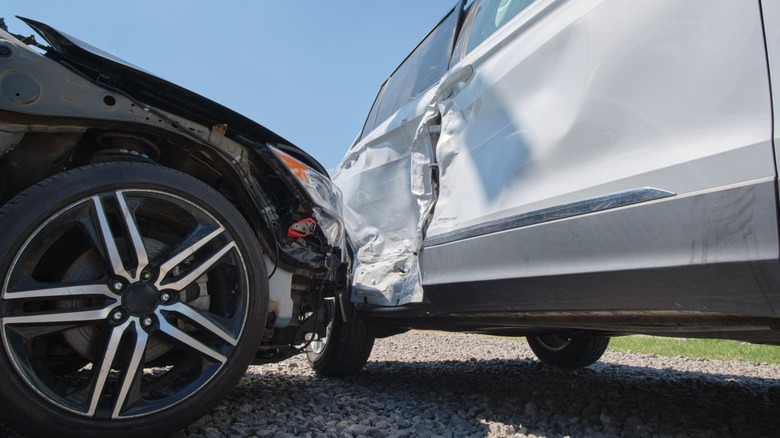Here's What Can Happen If Your Feet Are Up On A Dash During A Car Crash
We all have little habits we do unconsciously that we're trying to get rid of. Maybe you enjoy rocking your chair in a meeting, slouching in your seat, or cracking your knuckles. Most of the time, these habits are harmless, annoying maybe, but not dangerous. But then there are the ones that put your health at real risk, and one of them is putting your feet on the dashboard. It may be something you've probably done a couple of times without thinking too much about it.
But what if the unexpected happens, like a sudden stop or collision occurs? Nobody plans for it, but it happens every single day. And at that moment, your feet on the dash could turn a minor crash into a life-altering event. To make things worse, the very features designed to protect you, like airbags and seatbelts, can work against you if you're not sitting properly. Injuries from this position can be severe. We're talking broken bones, internal injuries, or a recovery that stretches on for months or longer, and replacing airbags is not exactly cheap. On top of that, you could even be riding in one of those cars that are not exactly collision-friendly.
This article isn't here to scare you, but to help you stay safe. We'll break down what actually happens when your feet are on the dash during a crash, why it matters, and how it interferes with your car's safety systems. Once you understand the risks, you'll see why this small habit carries some serious consequences and why it's worth giving up for good.
The irony of airbags
Airbags are designed to protect you in a crash by deploying at lightning speed, somewhere between 100 and 220 mph, to cushion your upper body and head from slamming into the car's interior. It's a pretty efficient system, one that has saved countless lives. But here's the irony: when your feet are resting on the dashboard, that same life-saving tool can become a source of serious injury.
The issue lies in just how fast and forceful that deployment is. There's no time to react, no chance to swing your legs down before the airbag blasts open. If your feet are up, they're right in the line of fire, and that force doesn't discriminate. With your knees pointed upward, the airbag can drive them straight into your face, breaking your nose, damaging your eyes, or even forcing your knees through your eye sockets.
Different leg positions come with different risks, but none of them are safe. If your legs are stretched flat across the dash, the airbag can shove them upward at an unnatural angle, snapping bones or dislocating your hips. Sitting crisscross? The force can twist your legs outward, damaging your hip joints or shattering your femur. We're talking about fractures, dislocations, and injuries that can seriously impact your ability to walk, often followed by months, maybe years, of painful recovery. The airbag doesn't adjust for your position. It explodes the same way every time, with the kind of power that's meant to save lives. But when you're slouched with your feet up, that force gets redirected. And instead of cushioning a blow, it delivers a lethal one instead.
Other reasons why you shouldn't put your feet up on a dash
Beyond the immediate danger of a crash, this position means you can't intuitively brace yourself for impact in case of an incoming hit, as you're not in a position to do so. There's also the issue of your seatbelt. It's your number one defense in a crash, designed to hold you firmly in place so you don't get thrown around. But when your feet are up on the dash, you're likely slouched down, and that changes everything. The seatbelt can't sit across your chest and lap and protect you like it's supposed to.
Then there's the matter of reacting in an emergency. On the road, things can go wrong fast: a sudden stop, a swerve to avoid something, or a quick brake to stay safe. As a passenger, you might need to help, but you're not in a position to act quickly. Your legs are not on the floor, so you're not grounded, which slows you down when every second counts. That delay could mean the difference between avoiding trouble and ending up in a worse situation.
Finally, it's not only about you; your choice can affect the people riding with you. If you're in a crash with your feet on the dash, the force of your legs getting pushed back by the airbag or the impact could transfer to others nearby. Maybe your body shifts into the driver, or your legs flail into someone else's space with enough force to injure them. Suddenly, one person's casual, relaxed position becomes everyone's problem.
Safety preventive measures you should take
While modern vehicles come with impressive safety features, you still play a huge role in how well those systems protect you. First and foremost, keep your feet off the dashboard. As comfortable as it might feel, the risks, now that you know them, just aren't worth it. Beyond that, a few small adjustments can go a long way toward keeping you safe, especially when you're driving on one of the most dangerous highways in the U.S.
The key is to sit in a way that works with the car's safety systems, not against them. Start by facing forward. This sounds obvious, but that alignment helps the airbags and seatbelt do their job. Make sure your seatbelt fits snugly across your chest and lap, not twisted or slack, and keep your feet planted flat on the floor. Your back and shoulders should rest fully against the back of the seat, with a small gap between the edge of the seat and the back of your knees. That setup gives you balance, control, and the best chance of walking away if something goes wrong.
If you're driving, there's a bit more to consider. Sit at least 10 inches from the steering wheel. You want to be close enough to drive comfortably, but far enough that the airbag doesn't hit you with full force if it deploys. Passengers should also keep some distance from the dashboard; about a foot is ideal to give the airbag space to deploy safely. Sitting upright like this won't guarantee you'll avoid injuries altogether, but it does mean those injuries are more likely to be manageable. And in a crash, every small detail, like the angle of your seat, the position of the belt, or your foot placement, can make all the difference.



